The Curious Relationship Between the Wasp and the Fig
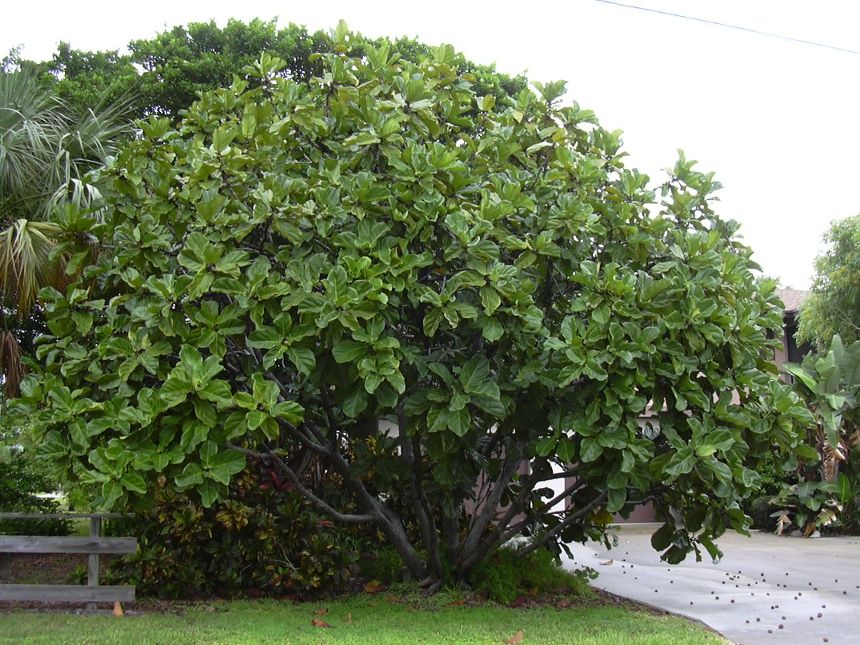
Ficus Lyrata, a variety of fig tree native to Africa. Image credit: Forest and Kim Starr. Used under a Creative Commons Attribution-Share Alike 3.0 Unported License, on Wikimedia Commons.
Most of us know civilizations arose when nomads settled down and became farmers. We likely learned that wheat and barley were planted, usually near a source of water. What many of us may not realize is that the first plant cultivated by humans was the fig. Fig cultivation predated grain cultivation by centuries. According to Harvard researchers, there is evidence of fig farming in the Near East that dates back about 11,400 years. Grain cultivation did not occur for another 1,000 years.
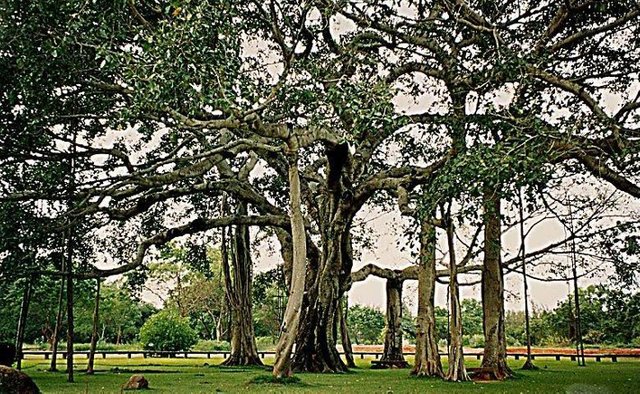
The Thimmamma Marrimanu, a 350-year-old banyan tree in Andhra Pradesh, India. Picture credit: Abdulkaleem md. Used under a Creative Commons Attribution-Share Alike 3.0 Unported license, on Wikimedia Commons.
The fig, it turns out, has played a distinguished role in human history, and in the ecology of our planet. References to the fig may be found in ancient texts, including Vedic scriptures and the Judeo-Christian Bible. The fig was highly regarded for its flavor, nutritive value and the magnificence of its display. The banyan tree, a variety of fig, holds a place of reverence in some cultures. India, for example, has declared the banyan its national tree. In Andhra Pradesh State, India, one of the most famous banyans, Thimmamma Marrimanu, is reported to be 350 years old, although its exact age cannot be determined. The tree is said to be among one of the largest in the world, if canopy size is measured. In Guatemala, the amate, another fig species is also considered to be the national tree.
Although the term "banyan tree" originally referred to the Indian banyan, different varieties of the tree exist around the world.
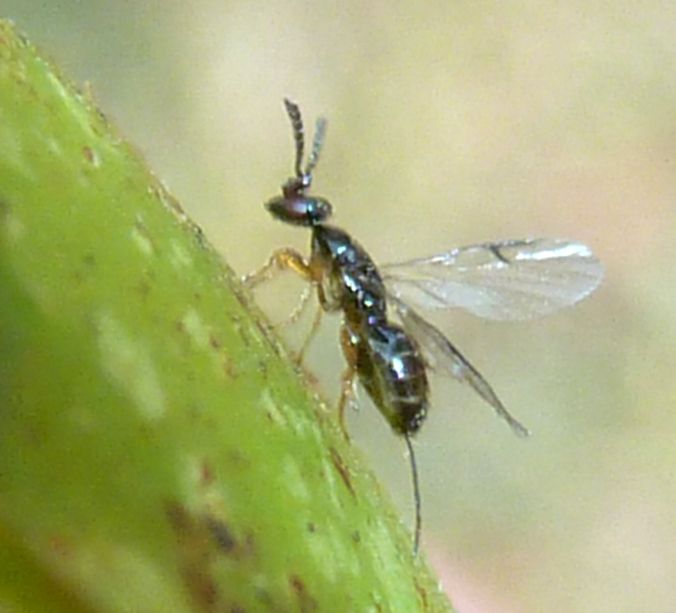
A pollinating fig wasp. The ovipositor, which the female uses to deposit eggs, is visible. The female will have to enter the fig to deliver her eggs because the ovipositor is not long enough to accomplish the task from the outside. Picture credit: JMK. Used under a Creative Commons Attribution-Share Alike 3.0 Unported license, on Wikimedia Commons.
The banyan tree is one of over 900 known fig (ficus) tree species (although Figweb puts the number at 755). Fig trees are part of the mulberry (Moraceae) family. For many people--for me--the most remarkable aspect of this tree is not its estimable history, revered status or enormous size. The most surprising aspect of this tree's life cycle is its method of propagation: In its natural state, the fig tree is dependent on an insect for reproduction. The insect is the fig wasp, and each fig species has a type of wasp that has developed to help the plant propagate--although some sources suggest certain wasps may be suited to more than one type of fig tree.
Were There Figs When Dinosaurs Walked the Earth?
Long before humans cultivated the fig, the trees existed in the wild. According to the American Institute of Biological Sciences, the fig originated some 80 to 90 million years ago. Dinosaurs disappeared about 66 millions years ago. So, yes, there were figs when dinosaurs walked the earth.
The Fig and the Wasp
The close relationship between the fig and the wasp, called mutualism, has also existed for millions of years, certainly for at least 34 million years. That's the estimated age of the oldest pollinating fig wasp fossil ever found. The fossilized wasp, in excellent condition, was discovered on the Isle of Wight in 1920. Remarkably, the wasp is almost identical to the modern fig wasp. The well-preserved specimen even bears evidence of pollen in its pollen pouch. It is in its role as carrier of pollen that the wasp became a critical vector in fig propagation.
The life cycle of the fig wasp begins inside a single fig. Males and females develop from larvae. After they exit the pupal stage, brothers and sisters mate. Their destinies, however, are very distinct. The female collects pollen from inside the fig. She does this passively, by merely having it stick to her body, or actively, by collecting it and storing it in her pouch. This explains the pollen found in the Wight Isle fossil.
The mature female wasp ultimately leaves the fig with her precious cargo, and flies away to another fig tree. There, she finds a single fig, locates a small hole, called an ostiole, at the top, and enters the fig. The ostiole is usually so narrow, that the wasp loses her wings and antenae upon entering. She is now trapped. The fig will become her tomb. She's indifferent to this fate, though, as she fulfills her biological imperative. She must lay her eggs and leave the pollen she has carried. She uses a highly specialized, stylus-like body part, called an ovipositor, to deposit her eggs inside minute flowers. As she does so, she pollinates the fig. When her mission is complete, the female wasp will perish. Her body will be dissolved in ficin (an enzymesecreted by the fig), but some body parts may remain.
From the labors of the female wasp will arise another generation of male and female wasps. The male's job, after mating, is less glorious but no less essential than his mate's. He must dig a hole, a passage, through the skin of the fig, to the outside. It is through this hole that females will leave the fig and go off to new territory. It is the fate of the male to perish there, or to go outside, briefly, and die. The female, endowed with pollen, will climb through the ostiole of a distant fig, as her mother had done before her, and repeat the life cycle that is her destiny.
Inside a fig syconium, where the drama of fertilization and pollination takes place. Picture credit: Prashanthns. Used under a Creative Commons Attribution-Share Alike 3.0 Unported license. Wikimedia Commons.
The place in which the drama, of entry, fertilization, birth and death takes place--inside the fig--is called a syconium, for the fig is not a true fruit. The syconium is a vessel that enables the life cycle of the wasp and propagation of the fig tree to proceed.
The Parasitic Fig Wasp
Besides the Wight Isle wasp fossil, another fossilized fig wasp has been found. This is a non-pollinating wasp, estimated to be 115 million years old. To some scientists, the existence of this wasp fossil suggests that figs might also have been around that long. However, without direct evidence, this is not an idea that has been accepted (though it is considered) by the research community.
Parasitic fig wasps swarm on the outside of a fig. Notice the very long ovipositors. Compare the shorter ovipositor on the pollinating wasp. The longer ovipositor allows the parasitic wasp to deposit its eggs without ever going inside the fig. Picture credit: Anthony Bain. Used under a Creative Commons Attribution-Share Alike 3.0 Unported license, on Wikimedia Commons.
The non-pollinating fig wasp is said to be parasitic. The parasitic fig wasp does not aid in propagation of the tree, but merely deposits its eggs in the fig. These eggs feed on the fig, and also, perhaps, on other wasp eggs. The parasitic fig wasp's elongated ovipositor spares her the danger of entering the ostiole and losing her wings. Her eggs can grow, and yet she donates no pollen to the tree. In a sort of karmic revenge, the fig tree often recognizes that it's been "had", and consequently dumps the fig with the parasitic eggs onto the ground. There the offspring of the parasite fig wasp perish.
Fig Distribution
Figs have wide global distribution, but their natural growth is limited to mostly tropical and subtropical zones. Where they do thrive, they are often a critical part of the environment. Many species are dependent upon them for food. Ficus, in these areas, has therefore been designated a keystone species. This means, if the fig tree disappeared, there would be a critical impact on the environment. But there is a certain balance between the needs of the tree, and needs of the species that depend on it.
As animals eat figs from the tree, they swallow seeds. They leave the tree, go some distance, and defecate. Through their waste, they deposit seeds that will take root and grow in a new location. Thus they aid in the fig tree's propagation.
Strangler Trees
One reason fig trees create enormous canopies, is because they often don't grow from the ground up, but rather, from the branch down. Seeds dropped by birds, likely through excrement, take root in the upper branches of a tree. From there they send roots to the earth, until the host tree is surrounded by a network of trunks that have grown from above. The host tree may be strangled by these numerous trunks. Although strangler trees use other plants as anchors, the stranglers are not considered parasites. They don't directly feed off the host and don't drain it of nutrients. However, they do deprive the host of sunlight and resources. They may literally "strangle" the host to death. Figs are not the only variety of tree that strangle. In the tropics, this pattern of growth is common.
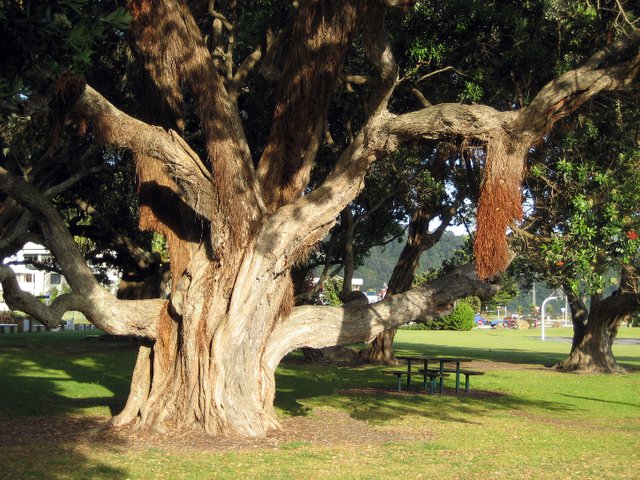
A New Zealand pohutukawa tree, with aerial roots descending. The pohutukawa is not a fig tree but does display a similar pattern of sending roots down to the ground from overhead branches. Picture credit: Kahuroa, who has released the photo into the public domain. Wikimedia Commons.
In some areas, strangler fig trees are considered an invasive species. It has been identified as such in California for example, and efforts to eradicate the invasive plant are afoot.
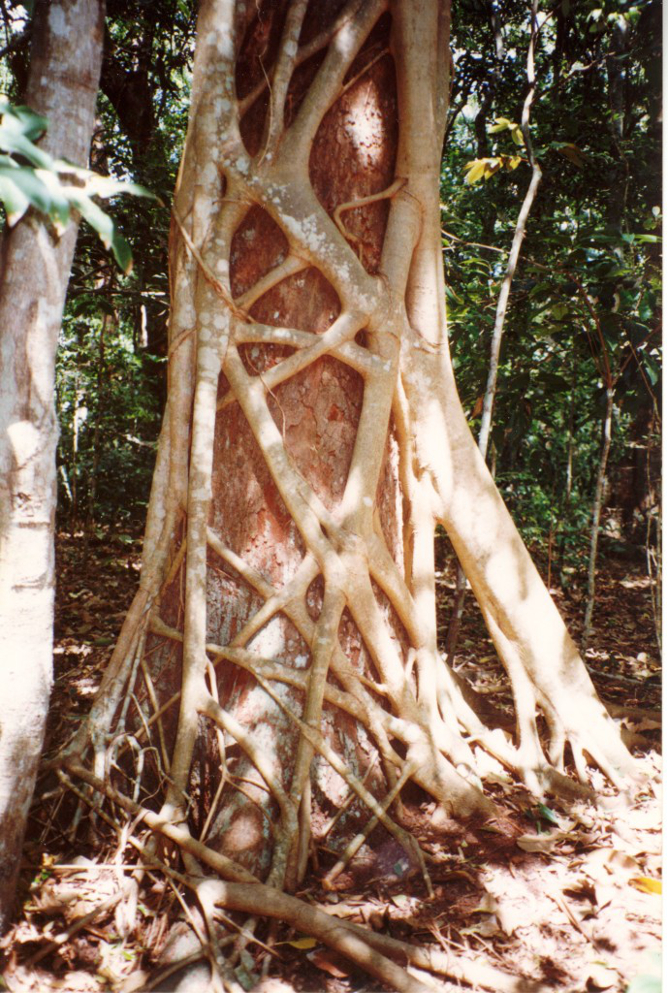
Picture of a Ficus Watkinsiana (Watkins' Fig), in New Zealand. The fig, with its many descending trunks, has surrounded the host tree completely. Image credit: Peter Woodard, who has released the photo into the public domain. Wikimedia Commons.
The Fig in Human History
While the fig tree today is regarded as a keystone species in the forest because of its importance to the ecosystem, through the ages the tree has also served an important role in human history. The Journal of Ethnobiology and Ethnomedicine reports that the sycamore fig was a food source for early hominids in Kenya during the Pliocene Epoch, 5.3 to 2.6 million years ago. Today, the fig tree is important to humans living in various African societies. The rock fig, for example, not only provides food, but also bark for tanning and dyeing, latex for traps and chewing gum, wood for charcoal and firewood.
Ancient Egyptians revered the fig tree. Pharaohs used wood from the tree to build their sarcophagi. They also took figs with them to their tombs so they would have nourishment in the afterlife.
According to Karen Carr, Professor of History at Portland State University, Oregon, the fig was probably introduced to China by travelers on the Silk Road in about 700 A. D. Today the fig plant is a significant food source in China.
Fig trees are an important commercial crop, food source, and ecosystem mainstay in the Americas. Their presence in commercial farming has grown in recent years.
The mutualism between fig and wasp does not occur in commercially grown fig trees. These trees are not dependent on wasps for reproduction. Propagation of figs without a wasp vector has been practiced for thousands of years. One method is to take a cutting from a mature fig tree and plant that cutting.
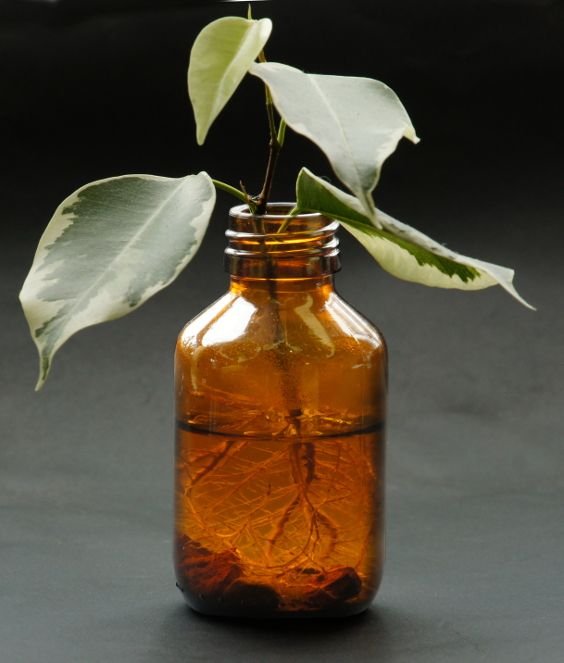
A fig cutting, growing in a bottle. Note the roots reaching downward. Picture credit: Biusch. Used under a Creative Commons Attribution-Share Alike 3.0 Unported license. Wikimedia Commons.
The subject of fig tree propagation is much broader than covered here. I have chosen to focus on the one aspect of the fig tree's life cycle that fascinates me. It is the mutualism between fig and wasp that has allowed both species to prosper for millions of years.
Yayyyyyy. I am so happy for you!
:) Checked my blog a few minutes ago and am really, really surprised. Thank you for your good wishes and encouragement.
I may have also shared your post with just a couple of people (haha). I am glad that they found it as valuable as I did.
Thanks again for your hard work!
"May have"? Thanks so much. Generous, truly generous.
I had a good read my friend @agmoore, I knew you had it all along. Very well written with extensive coverage of figs and the wasps. I enjoy nature and it does scare me too like the Strangler Trees ☺ - I have seen numerous but never got the term Strangler Tree, I learnt something new today.
I absolutely agree with @veckinon
Thank you so much. I guess Steemit rewards hard work. I love to write and I love to learn, so those two things come together here. And then I meet some very nice people :)
There is a contest for Steemians who are new. You might be interested. Someone suggested it to me the other day: contest.
Hope you have a great day.
This is an outstanding article. I enjoyed reading about the wasp/fig symbiosis, but honestly I was most intrigued by the strangler trees description. I have seen photos of such trees before but had no idea how the propagated.
You really deserve more attention for your writing. It is quite good. Thank you for sharing!
You made my night! I worked hard on getting the information together, but really enjoyed learning every bit of it. All new to me--except the dinosaurs :)
Great article! Many thanks
Thank you!
Terrific and informative article. Have to share it.
I appreciate that. Thank you!
That's really an awesome blog dear. And also congrats on getting curie's vote. Keep it up. I saw your post on SGG's contest for newbies. I am here to give you an upvote to help you win. Good luck dear.
Thank you so much! I will recommend the contest to other newbies.
Super informative. As a little kid, I had heard of fig wasps and went through a brief period where I was afraid of getting stung when eating the fruit.
As an adult, I'm partial to the idea that agriculture started as a way to make fermented beverages, rather than bread. I was initially worried when I read that figs may predate grain, but I'm happy to say that it looks like one can make a great drink out of them too (although, that's a distilled version).
I love the fact that you were worried about being stung--children get odd impressions. Glad to hear about fig fermentation :) Never know when that comes in handy. I couldn't resist looking up the history of fermentation--curiosity leads me down strange paths sometimes. Found this--https://eatcultured.com/blogs/news/fermentation-a-history. You never know, fermentation may have come first.
I like to believe so.
One of my favorite things is that the ancient Sumerian Hym to Ninkasi doubles as a recipe for brewing beer.
I can almost hear voices rising up as women set to work brewing beer. The Hym is wonderful. I may use that as a resource in the future. Thank you!
But the part of the article that tickled me most was the line: "many academics - who may, as a class, have special expertise in beer". Author was having a bit of fun there.
Do yourself a favor and lookup the etymology of symposium if you don't know it already ;)
I didn't know it, but do now! Thanks. Another wonderful bit of information.
Every day I learn, that I don't know nothing. Very informative and interesting blog. Thank you for enriching my knowledge.
Thank you for the lovely comment
Wow! So good! I’m really happy to see people rewarding your work because you deserve it. Very good article! I believe steemit should be a about learning from each other and being prosocial.
I can't tell you how positive my experience has been on Steemit. So many people are generous. Thank you, for your comment and for all your encouragement. Kindness is like a disease, but a good one. It's contagious--makes me want to do the same. :)
I’m glad you’re having this experience! I agree.. I also met wonderful people here who inspired me. Haha indeed :) let’s spread this disease!
This is a truly awesome piece of work! So well-researched and well-presented.
Many thanks :)